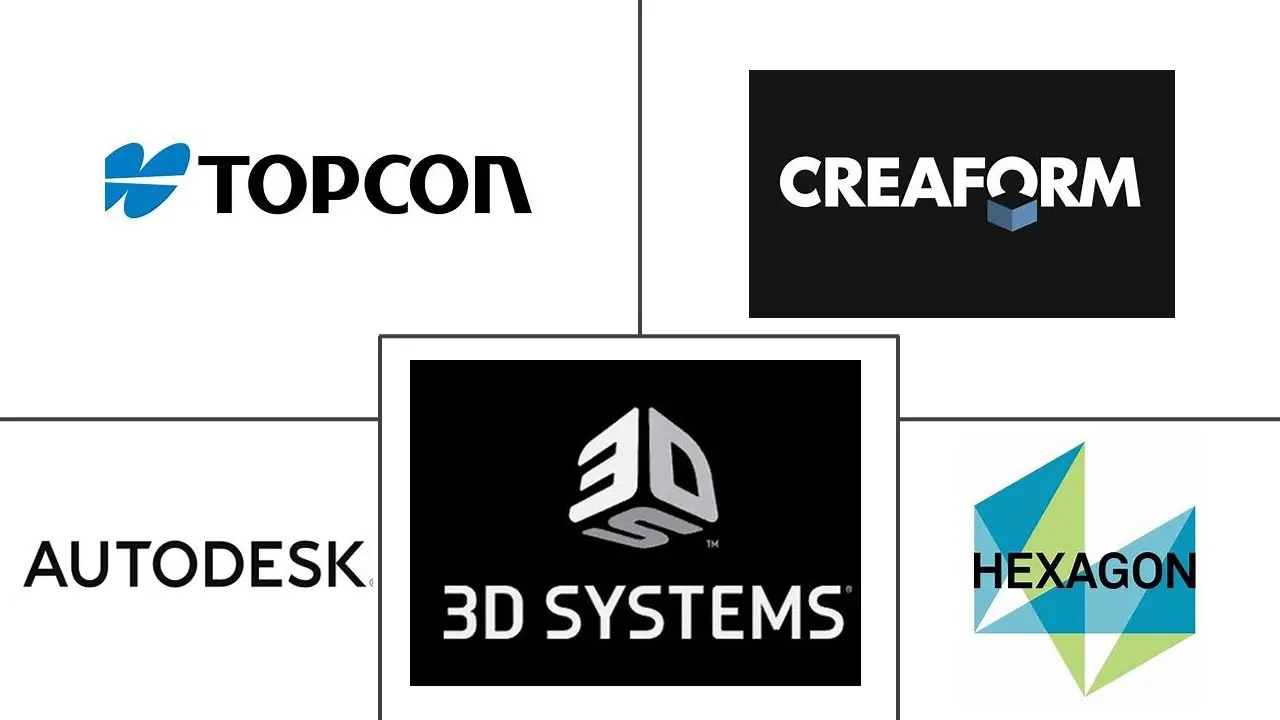3D Scanners Market Size and Share

3D Scanners Market Analysis by Mordor Intelligence
The 3D scanners market is valued at USD 4.09 billion in 2025 and is forecast to climb to USD 8.23 billion by 2030, advancing at a 15.01% CAGR. Expansion is underpinned by the rapid shift of 3D capture from specialist metrology labs to mainstream workflows in manufacturing, healthcare, cultural preservation and consumer electronics. Growth catalysts include artificial-intelligence engines that automate point-cloud post-processing, smartphone LiDAR modules that broaden user access, and electric-vehicle producers that need sub-millimetre measurement for lightweight battery assemblies. Laser scanners remain dominant yet structured-light devices are winning adoption owing to portability gains. Demand is also lifted by long-range infrastructure documentation projects and by face-and-body scanning for personalised healthcare.
Key Report Takeaways
- By technology, laser scanners led with 36% revenue share in 2024; structured-light devices are projected to record a 16.40% CAGR through 2030.
- By range, short-range systems accounted for 45% of the 3D scanner market size in 2024, whereas long-range scanners are projected to post a 16.20% CAGR through 2030.
- By application, quality control and inspection held 40% of the 3D scanners market size in 2024; face and body scanning is forecast to expand at a 17.60% CAGR.
- By end-user, industrial manufacturing captured a 27% market share of the 3D scanners market in 2024, while healthcare is expected to accelerate at a 17.90% CAGR through 2030.
- By geography, North America commanded a 38% share in 2024, and the APAC region is projected to outpace its peers with a 17.70% CAGR.
Global 3D Scanners Market Trends and Insights
Drivers Impact Analysis
| Driver | (~) % Impact on CAGR Forecast | Geographic Relevance | Impact Timeline |
|---|---|---|---|
| Rising demand for high-precision 3D metrology in lightweight EV platforms | +2.8% | Global with focus on North America and APAC | Medium term (2-4 years) |
| Additive-first aerospace design workflows require native 3D scan inputs | +2.1% | North America and Europe, expanding to APAC | Long term (≥ 4 years) |
| Shift to predictive maintenance twins in process industries | +1.9% | Global, early adoption in North America and Europe | Medium term (2-4 years) |
| Adoption of LiDAR-on-chip modules in next-gen smartphones | +3.2% | Global led by APAC factories | Short term (≤ 2 years) |
| Government digitisation of cultural-heritage assets | +1.4% | Europe and North America, expanding worldwide | Long term (≥ 4 years) |
| Falling ASPs of handheld scanners below USD 10,000 | +2.7% | Global with fastest uptake in emerging markets | Short term (≤ 2 years) |
| Source: Mordor Intelligence | |||
Rising demand for high-precision 3D metrology in lightweight EV platforms
Electric-vehicle builders now validate thin-walled battery trays and power-train castings using automated laser profilers that measure 680 features in under 140 seconds, trimming inspection cycles that once lasted hours. Sub-millimetre tolerances ensure thermal stability and crash safety, and vendors such as Marposs supply systems that scan 240 stator contacts in 30 seconds to enable 100% in-line checks. Widespread adoption across North American and APAC plants converts dimensional control into a real-time production gate rather than a post-process audit.
Additive-first aerospace design workflows require native 3D scan inputs
Engineers now assume that scan data will feed reverse-engineering, topology optimisation and final-part validation. Programmes such as NIST’s Measurement Science for Additive Manufacturing promote real-time data loops that embed scanning at each build layer.[1]NIST, “Measurement Science for Additive Manufacturing Program”, NIST, nist.govDemand therefore shifts towards systems that capture internal lattice geometries, pushing resolution thresholds while maintaining viable cycle times.
Shift to predictive maintenance twins in process industries
Refiners, chemical plants and power stations use high-density scans to enrich digital twins that forecast wear on pumps and compressors. Honeywell reports upstream projects that saved more than USD 10 million by correlating point clouds with IoT sensors for anomaly detection. The approach reduces unplanned shutdowns and unlocks new service-as-a-product revenue for scanner suppliers.
Restraints Impact Analysis
| Restraint | (~) % Impact on CAGR Forecast | Geographic Relevance | Impact Timeline |
|---|---|---|---|
| Persistent shortage of metrology-grade talent | -1.8% | Global, acute in North America and Europe | Long term (≥ 4 years) |
| Data-processing bottlenecks in >1-billion-point cloud projects | -2.1% | Global, affects large-scale projects | Medium term (2-4 years) |
| Source: Mordor Intelligence | |||
Persistent shortage of metrology-grade talent
Experienced operators who understand calibration and uncertainty budgets remain scarce. Lengthy upskilling cycles slow corporate rollouts and can trigger measurement errors that erode confidence in new equipment. The gap is most visible in regulated industries with zero-defect tolerance
Data-processing bottlenecks in >1-billion-point cloud projects
Billion-point files may exceed 188 GB, saturating typical workstations and delaying decisions. Progressive-rendering engines alleviate strain yet require costly GPUs and specialised staff. Misjudged infrastructure budgets lead to project overruns and discourage high-resolution workflows.
Segment Analysis
By Type: Structured Light Gains on Laser Dominance
Laser scanners retained a 36% share of the 3D scanner market in 2024, due to the time-of-flight accuracy prized by industrial and construction users. Structured-light units, however, are advancing at a 16.40% CAGR as portable rigs with AI-enabled surface reconstruction shrink setup effort. Hexagon’s StereoScan neo offers variable light projection, which manages both dark and shiny surfaces without the need for powder.
The 3D scanners market now values mobility almost as much as micron-level precision. Structured-light devices, such as the GOM Scan 1 package, utilize blue-light technology in sub-5 kg frames, opening access to small workshops and field engineers. Software suites that automate inspection and reverse-engineering expand revenues as hardware margins compress.
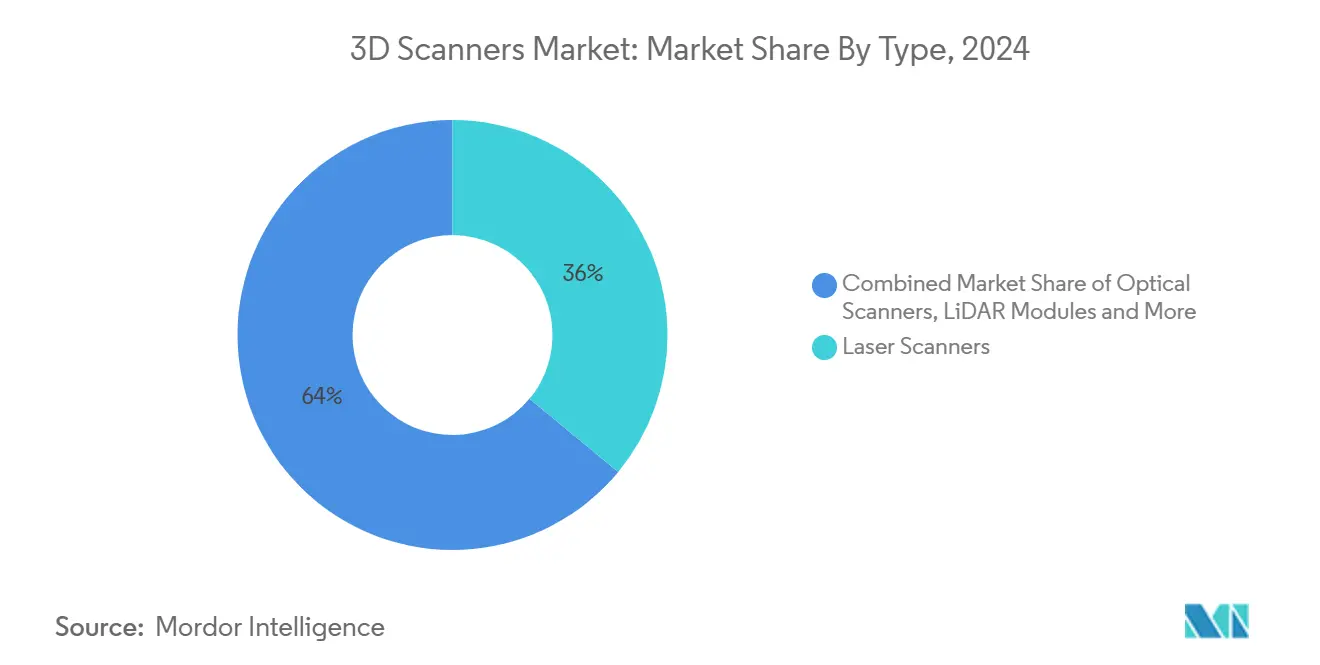
Note: Segment shares of all individual segments available upon report purchase
By Range: Long-Range Systems Accelerate Despite Short-Range Dominance
Short-range scanners captured 45% of the 3D scanners market size in 2024 thanks to their fit with high-volume manufacturing and medical workflows. Long-range devices with a range of over 30 m are expected to grow at a 16.20% CAGR, driven by infrastructure digitization and heritage preservation mandates, such as the EU's pledge to document all at-risk monuments by 2030.[2]Europeana, “Twin It! 3D for Europe’s Culture”, Europeana, europeana.eu
Adjustable-field products now blur traditional range classes. The wireless KSCAN-X covers volumes up to 2.6 m × 1.8 m, enabling aerospace technicians to toggle between body panels and cabin interiors without tripod moves. Wide-area capture generates recurring revenue from asset lifecycle models that pay for themselves over the course of decades of facility maintenance.
By Application: Face and Body Scanners Disrupts Traditional Metrology
Quality control and inspection held 40% of the 3D scanners market size in 2024 and remains a fundamentals-driven anchor segment. Face and body scanning is poised for a 17.60% CAGR as hospitals and consumer brands deploy non-contact capture for prosthetics, cosmetic planning, and virtual try-on. Creaform’s white-light healthcare line reduces patient discomfort and training time.
The demand for patient-centric models illustrates how the 3D scanners market transcends its industrial roots. Surgeons using Artec Eva visualise post-operative outcomes in minutes, improving consent rates and surgical precision. Parallel interest from the fitness and apparel sectors broadens volume potential beyond clinical environments.
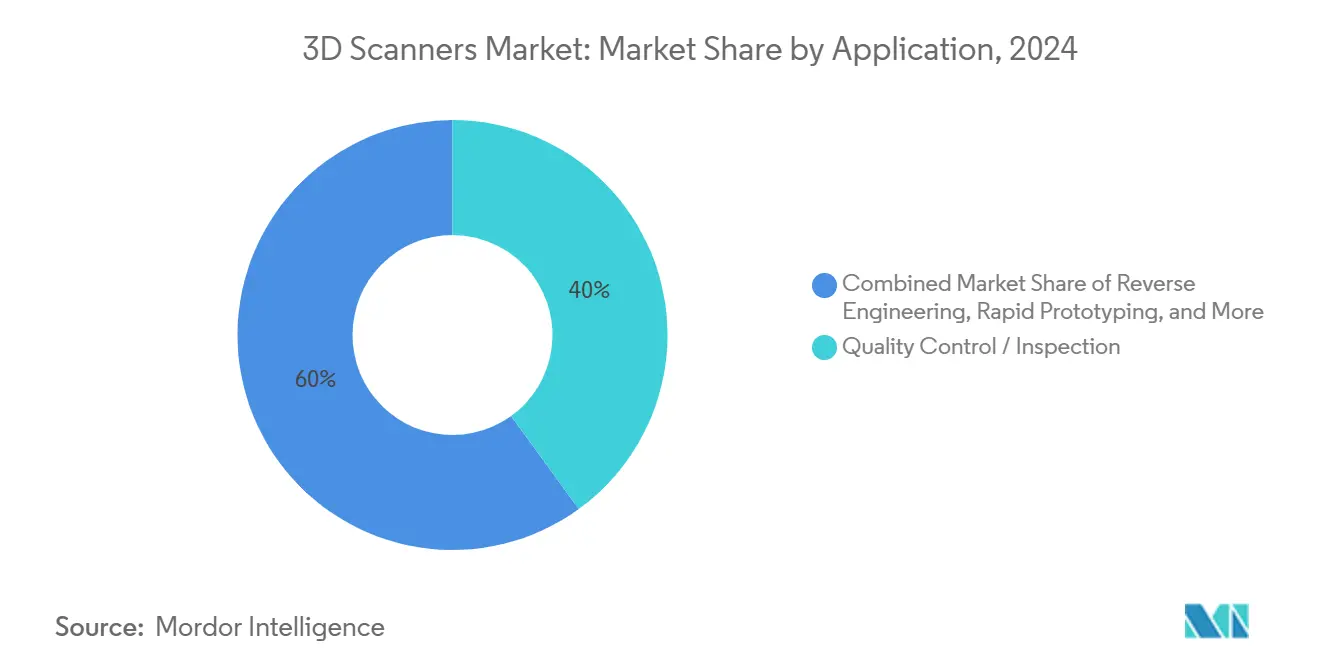
Note: Segment shares of all individual segments available upon report purchase
By End-User: Healthcare Accelerates Past Industrial Manufacturing
Industrial manufacturing kept a 27% anchor share in 2024 by embedding automated gauges on production lines. Healthcare is expected to lead growth with a 17.90% CAGR as scanning migrates from R&D labs to frontline clinics for dental, orthotic and surgical tasks. Regulatory pathways that classify scanners as medical devices encourage vendors to refine ergonomic design and data security.
Academic and cultural organisations also expand adoption. The British Museum digitised more than 400 Maya casts with Artec Eva, showcasing preservation use cases that attract public funding. Similar programmes across universities and archives underline the technology’s societal reach
Geography Analysis
North America accounted for 38% of the 3D scanners market in 2024. The region benefits from long-established metrology standards, aerospace primes that demand micron-level documentation, and policy incentives for digital manufacturing. Canadian hubs house global service centres for suppliers such as Creaform, ensuring close-range technical support. United States OEMs are now integrating scanners into additive manufacturing cells to verify each build layer, while Mexico’s expanding EV production is adding volume orders for in-line gauges.
APAC is forecast to deliver the highest 17.70% CAGR to 2030. China’s 3D industrial camera revenues rose 28.35% year on year in 2024, driven by robotics and automated optical inspection. Japan leads wireless innovation through launches such as KSCAN-X, and South Korea embeds scanners in semiconductor and electronics assembly. India and Southeast Asia add upside as new industrial corridors seek affordable quality-assurance tools.
Europe posts steady gains rooted in automotive innovation and the digitisation of heritage sites. Funding streams that target culture, such as the EU Twin It programme, guarantee long-range project pipelines. Germany’s EV supply chain upgrades dimensional control, while Nordic construction firms adopt scan-to-BIM to curb cost overruns. The Middle East, Africa and South America remain nascent yet show rising demand in mining, energy and preservation projects.
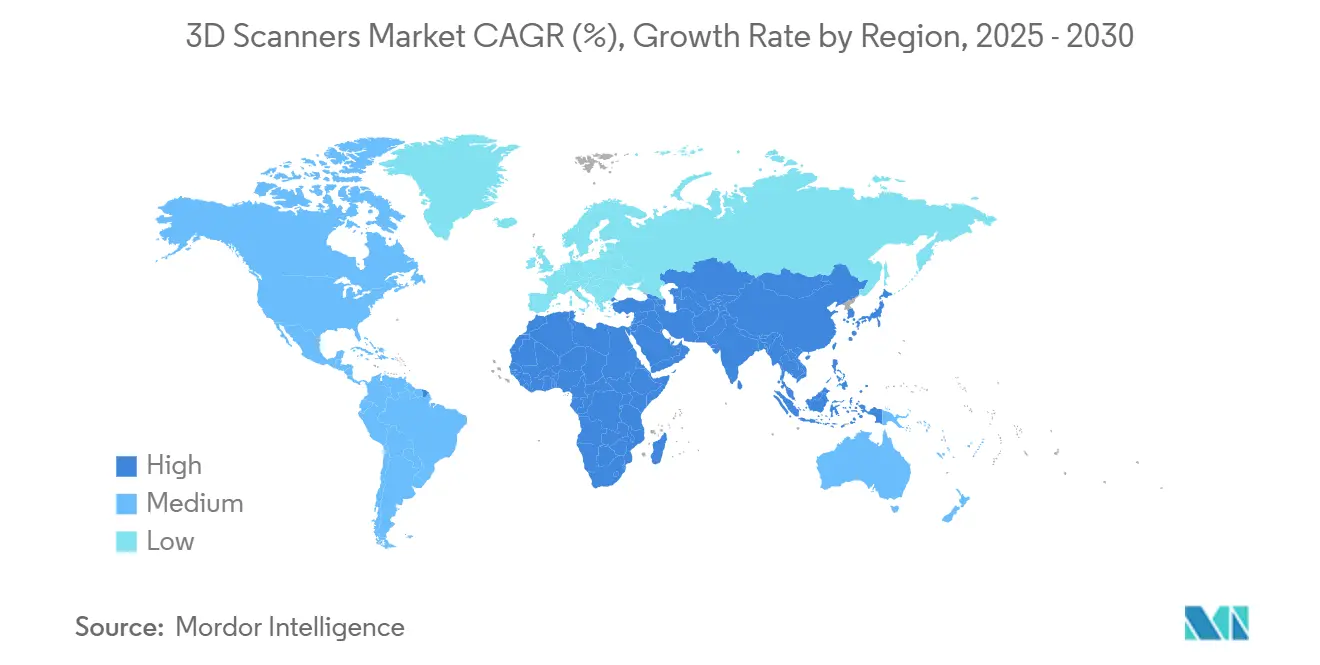
Competitive Landscape
The 3D scanners market features moderate fragmentation. Hexagon, FARO, and Trimble leverage acquisition strategies to unite hardware, software, and services. Hexagon’s USD 123 million purchase of Geomagic embeds modelling and inspection engines inside its hardware stack, streamlining customer workflows.[3]Hexagon, “Hexagon acquires inspection and 3D modelling software capabilities from 3D Systems”, Hexagon, hexagon.com
Incumbents now compete on integrated platforms rather than isolated devices. FARO’s Focus Premium Max and Quantum X Arm refresh its metrology portfolio while Topcon’s alliance with FARO extends distribution reach into construction and surveying.[4]Topcon, “Topcon and FARO Technologies announce strategic agreement in laser scanning technology”, Topcon, topconpositioning.com Cloud specialists, such as Cintoo, attract venture capital by compressing and streaming point clouds, thereby lowering the total cost of ownership for remote teams.
Smartphone LiDAR and AI-driven automation threaten to commoditise entry-level tiers. Incumbents respond by bundling workflow consulting, maintenance contracts, and training services, locking in enterprise clients and protecting margins. Opportunities remain in vertical-specific analytics modules and plug-and-play robotic inspection cells.
3D Scanners Industry Leaders
-
3D Systems Inc.
-
Topcon Corporation
-
Autodesk Inc.
-
Hexagon AB
-
Creaform (AMETEK)
- *Disclaimer: Major Players sorted in no particular order
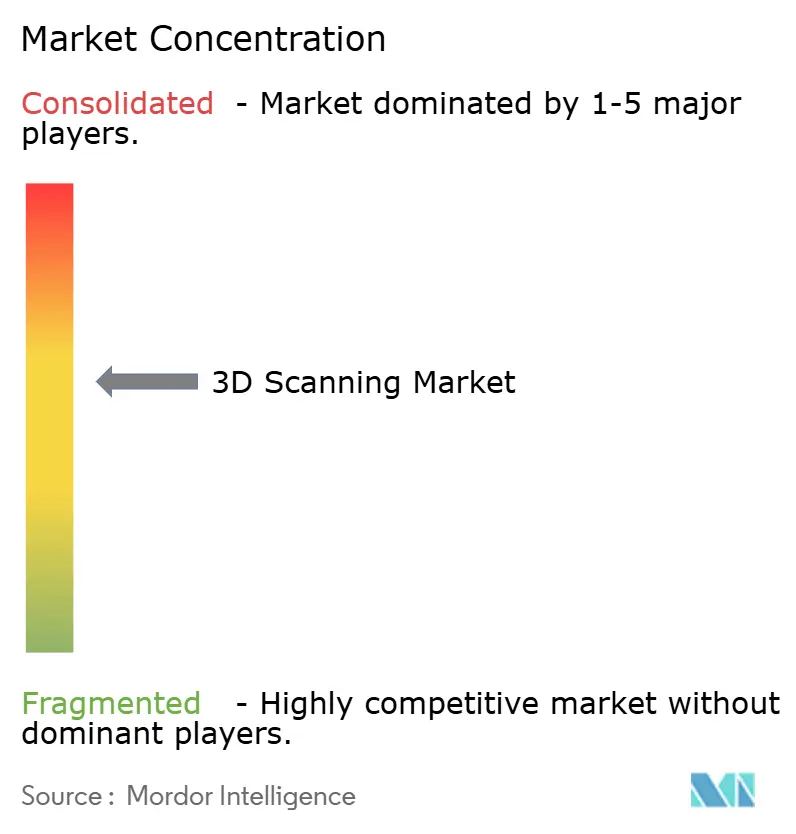
Recent Industry Developments
- May 2025: Topcon and FARO agreed to co-develop integrated laser-scanning solutions for construction and BIM, pooling channel assets.
- April 2025: APPLE TREE launched the wireless KSCAN-X in Japan to tap aerospace and heavy-machinery demand for untethered wide-area capture.
- October 2024: Hexagon bought 3D Systems’ Geomagic software for USD 123 million, strengthening scan-to-analysis integration.
- June 2024: Scantech unveiled NimbleTrack and AM-CELL C automated scanners to capture additive-manufactured parts inside production cells.
Research Methodology Framework and Report Scope
Market Definitions and Key Coverage
Our study defines the 3D scanners market as all hardware and tightly linked software that capture surface geometry or volume data through laser, structured light, photogrammetry, or LiDAR modules to create measurable three-dimensional point clouds and meshes, valued in USD at first sale. The scope tracks shipments and associated software licenses sold to end users in manufacturing, healthcare, construction, heritage, media, and other verticals.
Scope exclusion: After-market service contracts, stand-alone CAD/CAM suites, and custom one-off scanning rigs are excluded.
Segmentation Overview
- By Type
- Hardware
- Optical Scanners
- Structured-Light Scanners
- Laser Scanners
- LiDAR Modules
- Photogrammetry Rigs
- Other Hardware
- Software
- Scanning Software
- Inspection / Metrology Suites
- Reverse-Engineering Suites
- Hardware
- By Range
- Short Range (≤1 m)
- Medium Range (1-30 m)
- Long Range (≥30 m)
- By Application
- Reverse Engineering
- Rapid Prototyping
- Quality Control / Inspection
- Industrial Metrology
- Face and Body Scanning
- Digital Modeling / Animation
- BIM and Scan-to-CAD
- Heritage Preservation and Archaeology
- By End-User Vertical
- Aerospace and Defense
- Automotive
- Healthcare (incl. dental, orthotics)
- Manufacturing and Industrial
- Architecture, Engineering and Construction
- Media and Entertainment
- Energy and Utilities
- Consumer Electronics
- Academia and Research
- By Geography
- North America
- United States
- Canada
- Mexico
- South America
- Brazil
- Argentina
- Colombia
- Chile
- Rest of South America
- Europe
- Germany
- United Kingdom
- France
- Italy
- Spain
- Netherlands
- Sweden
- Russia
- Rest of Europe
- APAC
- China
- Japan
- South Korea
- India
- Australia and New Zealand
- ASEAN
- Rest of APAC
- Middle East and Africa
- Middle East
- Saudi Arabia
- UAE
- Qatar
- Turkey
- Rest of Middle East
- Africa
- South Africa
- Nigeria
- Egypt
- Kenya
- Rest of Africa
- Middle East
- North America
Detailed Research Methodology and Data Validation
Primary Research
Mordor analysts interviewed scanner OEM engineers, metrology lab managers, heritage conservators, dental lab owners, and BIM consultants across North America, Europe, and Asia Pacific. These conversations refined average selling prices, usable life, and emerging adoption hurdles, and they validated our segmentation splits before numbers were locked.
Desk Research
We begin with open datasets from bodies such as the National Institute of Standards and Technology, United States International Trade Commission, Eurostat Comext, and the World Customs Organization to map cross-border scanner flows. Industry associations such as the Association for Advancing Automation, the American Dental Association, and the International Committee for Documentation assist us in sizing vertical demand pockets. Public filings, patent counts accessed through Questel, and press releases enrich trend tracking. D&B Hoovers supports revenue checks on key producers. This list is illustrative; many other public and subscription sources fed the baseline.
Market-Sizing & Forecasting
A top-down reconstruction from production plus trade data is cross-checked with sampled bottom-up roll-ups of supplier revenues and channel checks. Variables fed into the model include average scanner ASP progression, installed base retirement rates, automotive and aerospace production indices, dental CAD/CAM procedure counts, and BIM project penetration. Multivariate regression blended with short-term ARIMA captures both structural drivers and near-term cycles, while scenario analysis stress tests currency and supply chain shocks. Missing bottom-up datapoints are bridged by range-specific ASP proxies gathered during interviews.
Data Validation & Update Cycle
Outputs pass two analyst reviews, variance checks against independent indicators, and anomaly flags are re-queried with sources. Reports refresh every twelve months, with interim updates triggered by material events such as major technology launches or tariff shifts.
Why Mordor's 3D Scanners Baseline Earns Decision-Maker Trust
Published estimates often diverge because firms choose different product mixes, price points, and refresh cadences. By anchoring on clearly defined hardware and bundled software revenue and refreshing annually, Mordor Intelligence limits those distortions.
Key gap drivers stem from whether value-added software is counted, if rental and service revenue is rolled in, and how price normalization across short, medium, and long-range devices is handled. Our disciplined scope, verified ASP ladder, and yearly model review reduce these swings.
Benchmark comparison
| Market Size | Anonymized source | Primary gap driver |
|---|---|---|
| USD 4.09 Bn | Mordor Intelligence | - |
| USD 4.65 Bn | Regional Consultancy A | Omits bundled inspection and reverse-engineering suites, narrowing scope |
| USD 6.10 Bn | Global Consultancy B | Adds service bureau and rental revenue that inflates totals |
| USD 2.25 Bn | Trade Journal C | Counts hardware shipments only and uses list prices without range weighting |
The comparison shows that when scope creep or scope shrink occurs, headline values swing widely. Our model, rooted in transparent variables and repeatable steps, therefore offers the balanced, traceable baseline buyers can rely on.
Key Questions Answered in the Report
What is the current value of the 3D scanners market?
The market is valued at USD 4.09 billion in 2025.
How fast will the 3D scanners market grow by 2030?
It is projected to expand at a 15.01% CAGR and reach USD 8.23 billion by 2030.
Which region is forecast to be the fastest-growing?
APAC is set to advance at a 17.70% CAGR through 2030 owing to industrialisation and government digitisation.
What technology segment shows the highest growth?
Structured-light scanners are expected to log a 16.40% CAGR because of portability and AI-powered reconstruction.
Why is healthcare a key opportunity in the 3D scanners market?
Healthcare applications, including dental, prosthetics and surgical planning, are predicted to grow at 17.90% CAGR as scanning transitions into regulated medical workflows.
Page last updated on:
